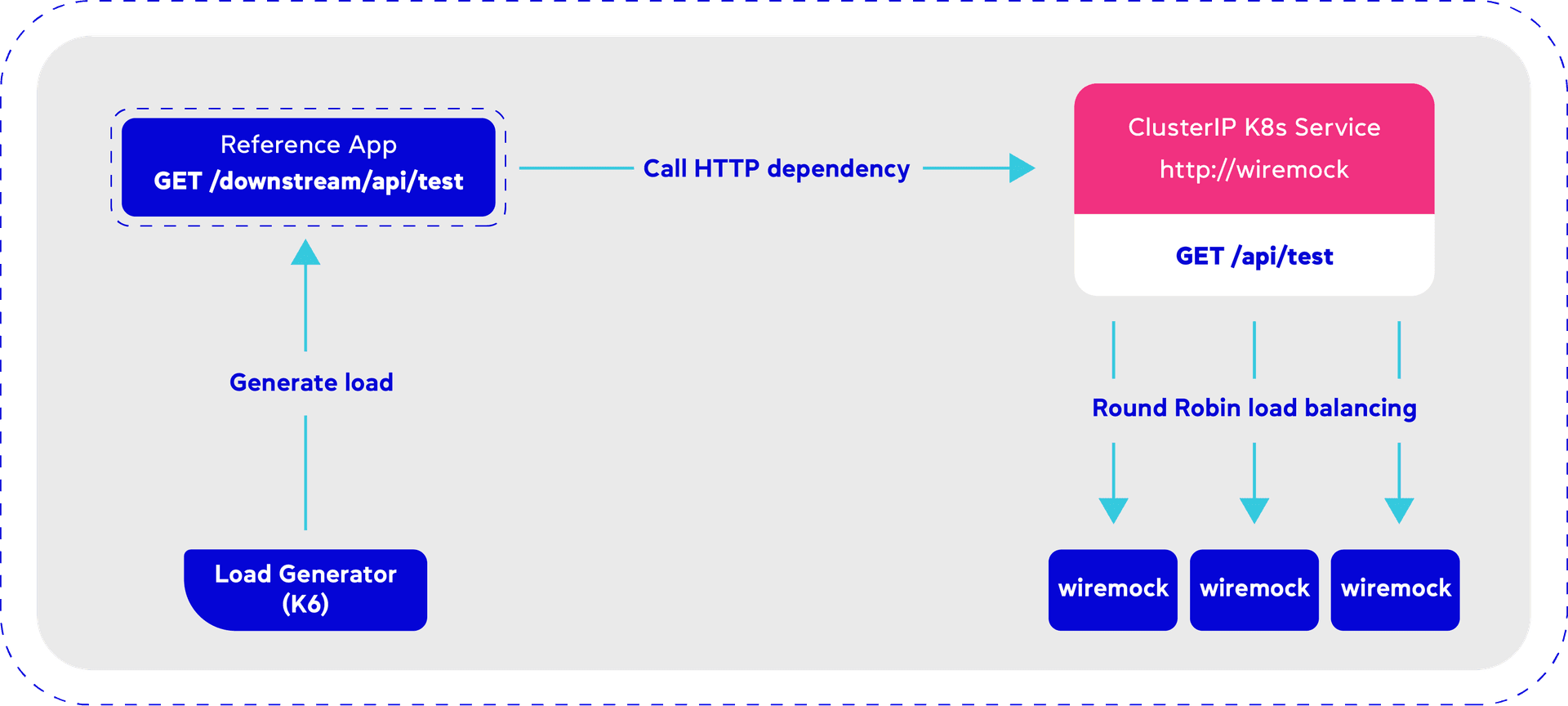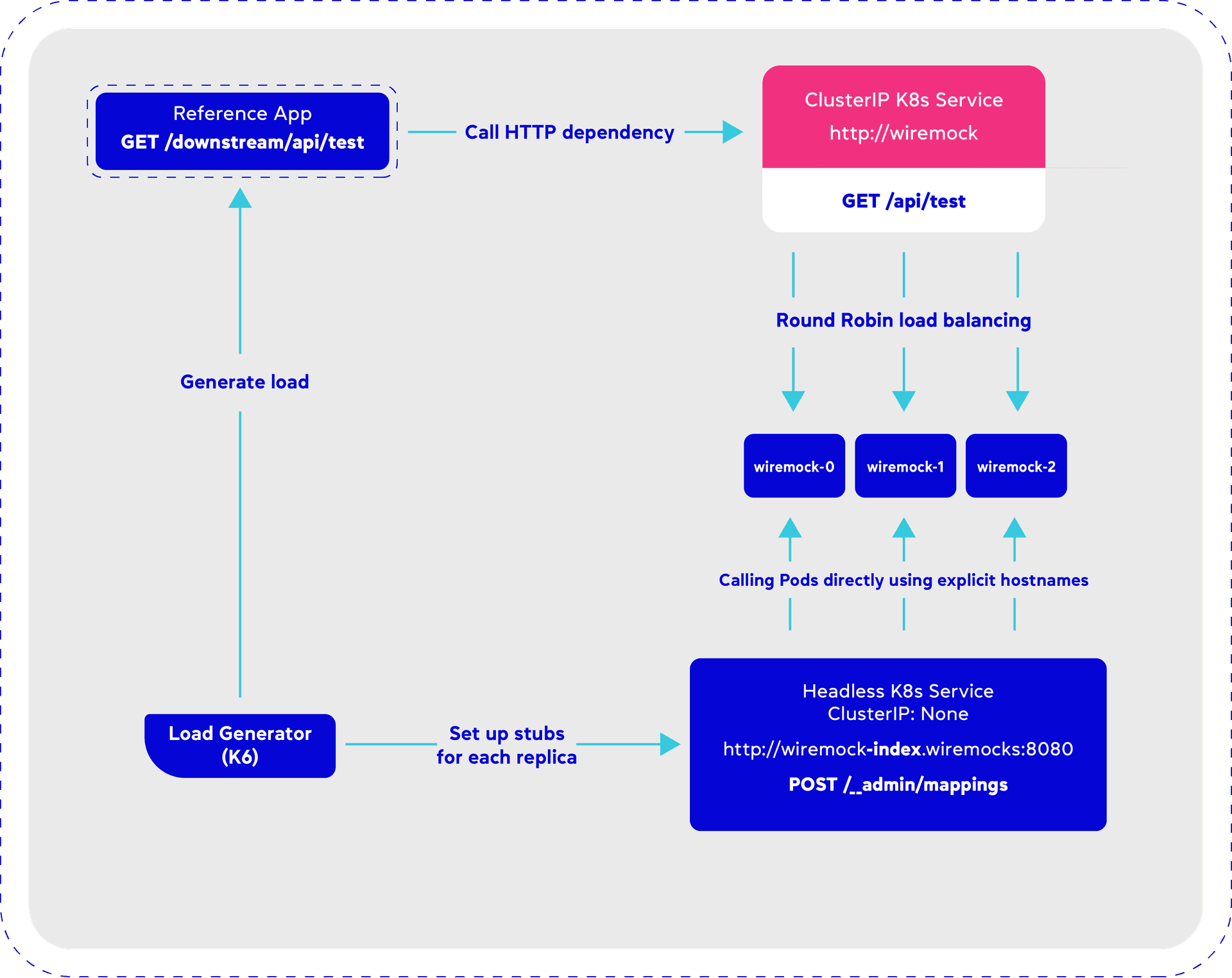Scaling an http stub for load testing
Learn how to scale an HTTP stub for high-performance load testing using WireMock in Kubernetes. This post covers strategies for horizontal scaling, handling dynamic mappings with StatefulSets, and configuring a load generator for effective non-functional testing.

Introduction
Stubbed testing at CECG

Why WireMock
Static stub mappings
---
apiVersion: v1
kind: ConfigMap
metadata:
name: wiremock-mappings
data:
static.json: |-
{
"request": {
"method": "GET",
"url": "/static"
},
"response": {
"status": 200,
"jsonBody": {
"data": "static"
},
"headers": {
"Content-Type": "application/json"
}
}
}
volumeMounts:
- name: wiremock-mappings-volume
mountPath: /home/wiremock/mappings
Dynamic stub mappings
POST /__admin/mappings endpoint.
Tuning WireMock for high performance
-
--no-request-journalDisable the request journal, which records incoming requests for later verification.
-
--disable-request-loggingPrevent requests and responses from being sent to the notifier.
-
--async-response-enabled=trueEnable asynchronous request processing in Jetty.
Scaling WireMock horizontally
http://wiremock
---
apiVersion: apps/v1
kind: Deployment
metadata:
name: wiremock
labels:
app.kubernetes.io/name: wiremock
spec:
replicas: 3
selector:
matchLabels:
app.kubernetes.io/name: wiremock
template:
metadata:
labels:
app.kubernetes.io/name: wiremock
spec:
containers:
- name: wiremock
image: wiremock/wiremock:3.4.2
args:
- "--no-request-journal"
- "--disable-request-logging"
- "--async-response-enabled"
- "true"
volumeMounts:
- name: wiremock-mappings
mountPath: /home/wiremock/mappings
livenessProbe:
httpGet:
port: 8080
path: /static
readinessProbe:
httpGet:
port: 8080
path: /static
ports:
- containerPort: 8080
volumes:
- name: wiremock-mappings
configMap:
name: wiremock-mappings
---
apiVersion: v1
kind: Service
metadata:
name: wiremock
spec:
selector:
app.kubernetes.io/name: wiremock
ports:
- protocol: TCP
port: 80
targetPort: 8080
Problem with dynamic mappings
StatefulSet to the rescue
---
apiVersion: apps/v1
kind: StatefulSet
metadata:
name: wiremock
labels:
app.kubernetes.io/name: wiremock
spec:
serviceName: wiremocks
replicas: 3
selector:
matchLabels:
app.kubernetes.io/name: wiremock
---
apiVersion: v1
kind: Service
metadata:
name: wiremocks
spec:
clusterIP: None # headless
selector:
app.kubernetes.io/name: wiremock
ports:
- protocol: TCP
port: 8080
targetPort: 8080
+ kubectl get pods -l app.kubernetes.io/name=wiremock
NAME READY STATUS RESTARTS AGE
wiremock-0 1/1 Running 0 2h
wiremock-1 1/1 Running 0 2h
wiremock-2 1/1 Running 0 2h
http://wiremock-{index}.wiremocks:8080
Load generator setup
import { check } from "k6";
import http from "k6/http";
export function registerStubMapping(replicas, stubMappingDefinition) {
for (let i = 0; i < replicas; i++) {
const replicaEndpoint = `http://wiremock-${i}.wiremocks:8080`;
callWiremock(replicaEndpoint, stubMappingDefinition);
}
}
function callWiremock(endpoint, stubMappingDefinition) {
const url = `${endpoint}/__admin/mappings`;
const params = {
headers: {
"Content-Type": "application/json",
},
};
const res = http.post(url, JSON.stringify(stubMappingDefinition), params);
check(res, {
"stub mapping created": (r) => r.status === 201,
});
}
import { check } from "k6";
import http from "k6/http";
import { registerStubMapping } from "./wiremock.js";
const wiremockReplicas = 3;
const testData = "testing-data-string";
export const options = {
scenarios: {
loadTest: {
executor: "constant-arrival-rate",
rate: 1000,
timeUnit: "1s",
duration: "3m",
preAllocatedVUs: 200,
},
},
thresholds: {
checks: ["rate>0.99"],
http_reqs: ["rate>999"],
http_req_failed: ["rate<0.01"],
http_req_duration: ["p(99)<500"],
},
};
export function setup() {
registerStubMapping(wiremockReplicas, {
request: {
method: "GET",
url: "/api/test",
},
response: {
status: 200,
jsonBody: {
data: testData,
},
headers: {
"Content-Type": "application/json",
},
},
});
}
export default function () {
const res = http.get("http://reference-service/downstream/api/test");
check(res, {
"status is 200": (r) => r.status === 200,
"response body contains stubbed data": (r) => r.body.includes(testData),
});
}
Summary
This article is provided as a general guide for general information purposes only. It does not constitute advice. CECG disclaims liability for actions taken based on the materials.
Continue Reading
Discover more insights from our blog collection

Explore how Internal Developer Platforms (IDPs) streamline common development processes through interfaces like CLI tools, developer portals, and platform orchestrators. This post examines the pros and cons of each approach to help you optimize developer workflows.

Explore emerging trends in CI/CD pipelines that challenge conventional processes, advocating for script-based approaches, local execution capabilities, and tools like Dagger for more dynamic and adaptable workflows.

Learn how we implemented identity-based authentication for a developer platform using Google Identity-Aware Proxy (IAP) on GKE. This post covers our technical approach, from ingress architecture to overcoming IAP limitations, to provide secure, seamless access to internal services.